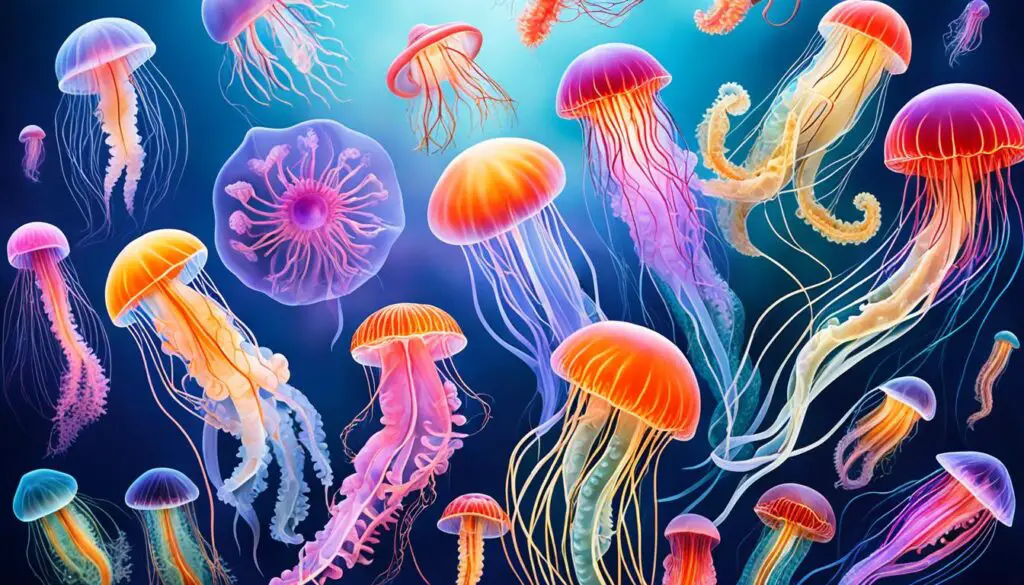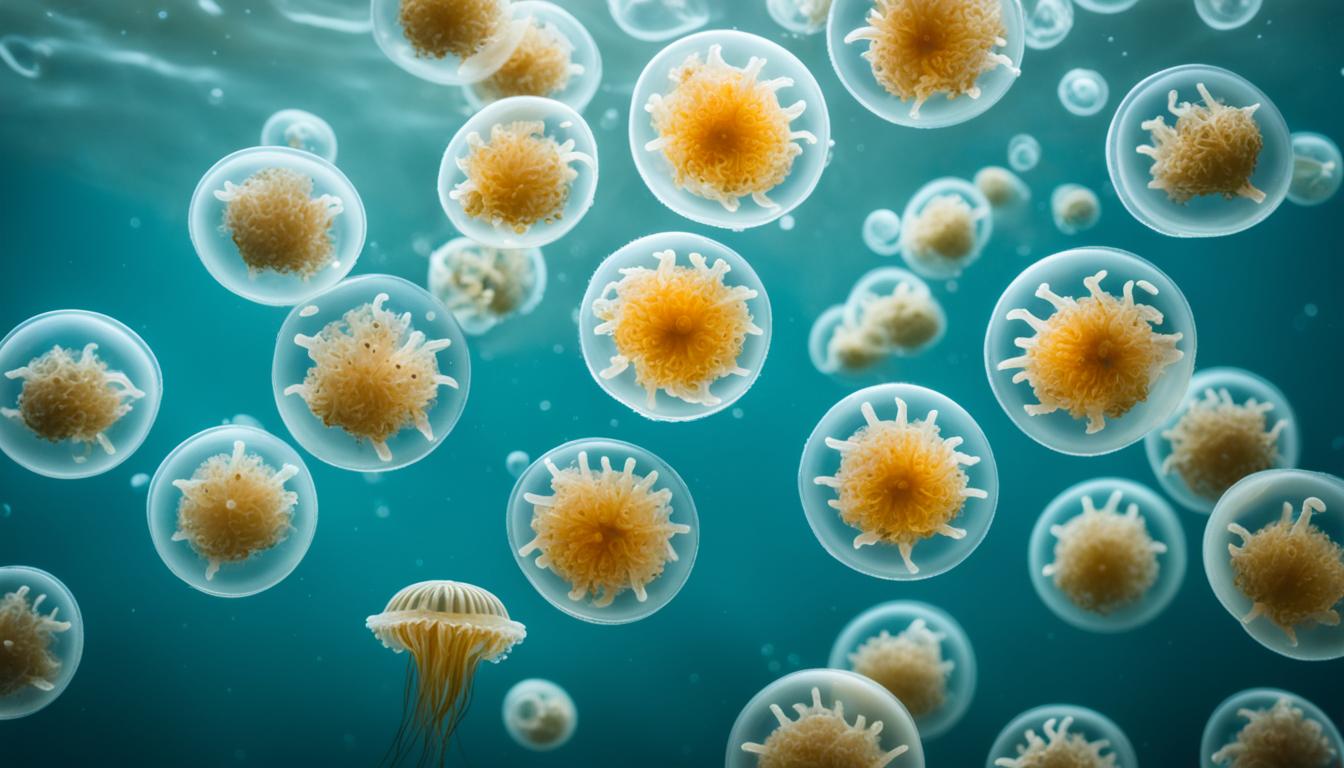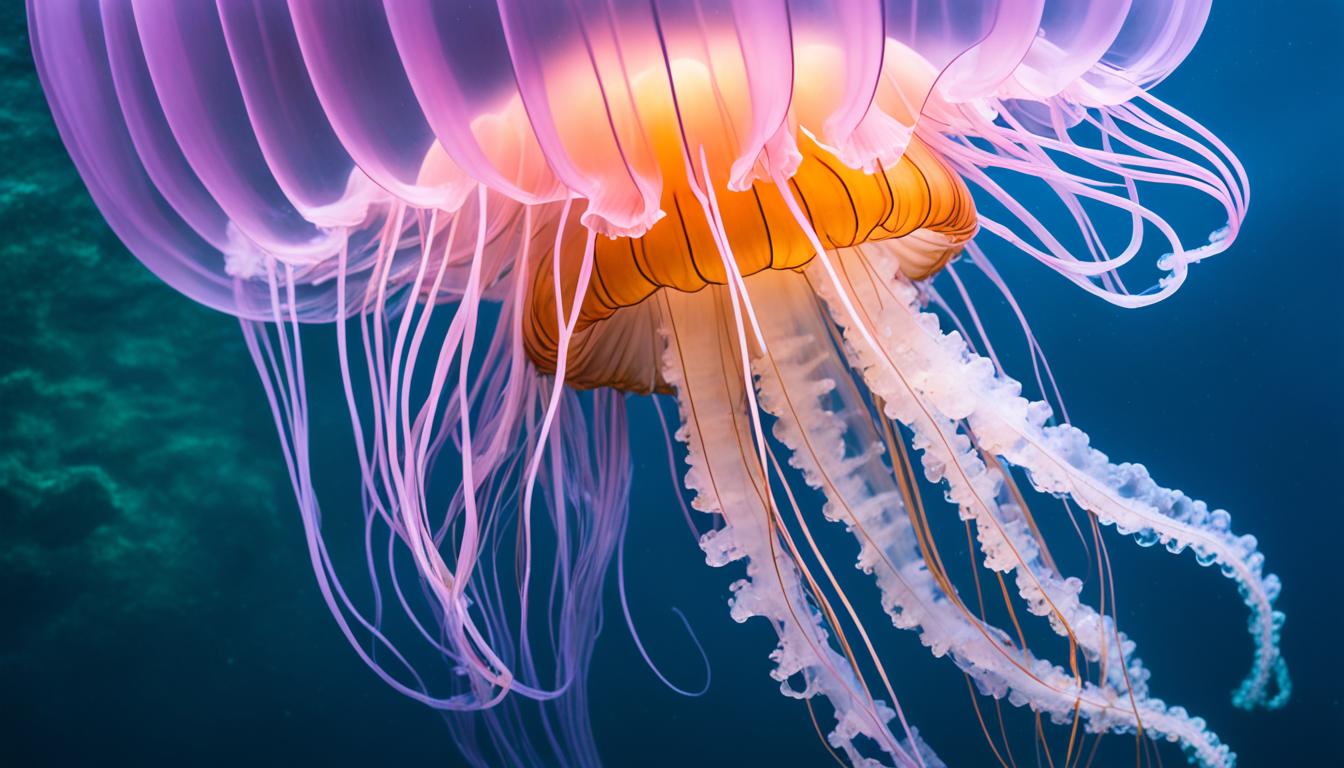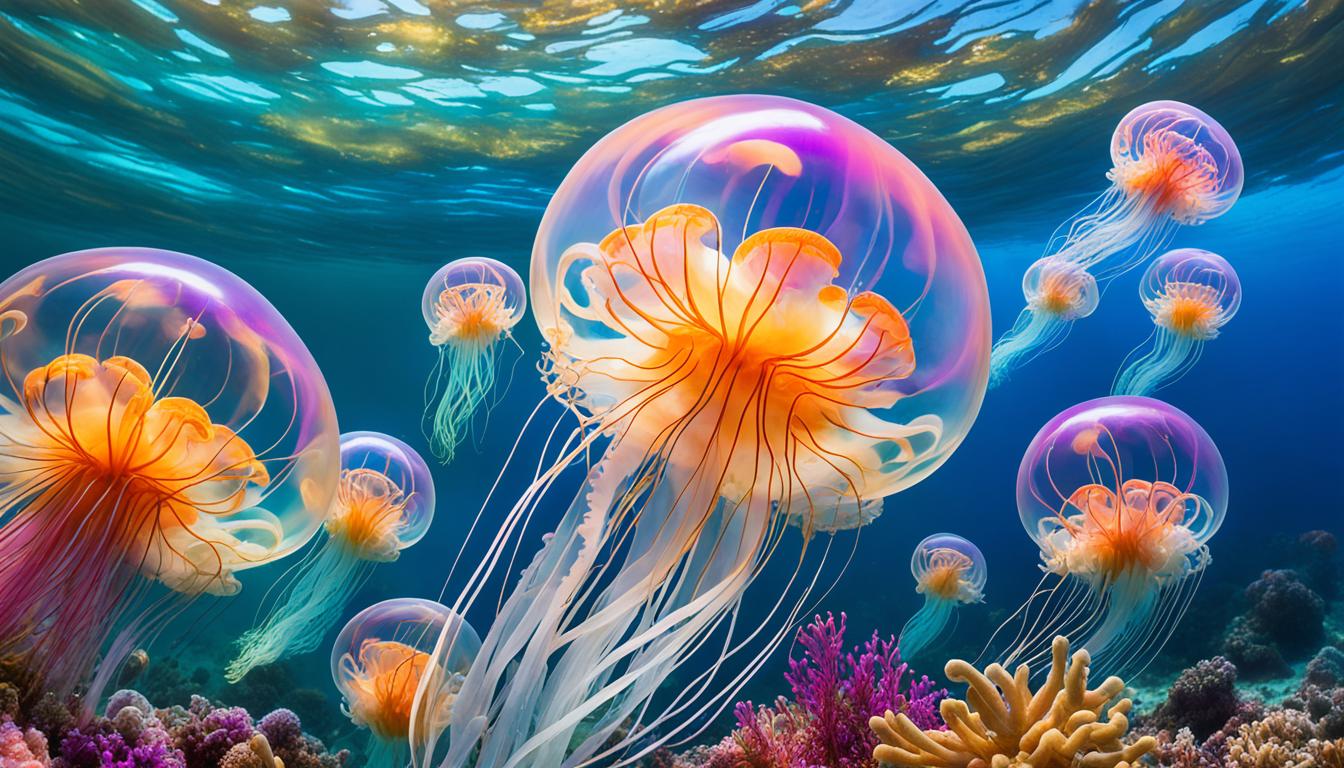Jellyfish have always fascinated marine biologists and fans because of their unique way of reproducing. This section will look into how jellyfish reproduce. We’ll see the different ways they ensure their species continues. From complex sexual processes in medusae to simple asexual methods in polyps, each way is vital to their life cycle.
It’s key to understand jellyfish breeding habits to see their role in the ocean. As we dive deeper, you’ll learn about the amazing strategies these creatures use to survive in the sea.
Introduction to Jellyfish Reproduction
Jellyfish have many ways to reproduce, depending on their life stage. Most are in the class Scyphozoa. They use both sexual and asexual methods to keep their species going. This shows how complex their life cycle is.
To understand how do jellyfish reproduce, let’s look at their two main ways. Sexual reproduction happens in the medusa stage. Adults release sperm and eggs into the water, which leads to fertilization. On the other hand, asexual reproduction occurs in the polyp stage, mainly through budding. This flexibility helps jellyfish survive in different environments.
Even though their methods vary, their goal is the same: to keep their species alive. By using both sexual and asexual reproduction, jellyfish can adapt to changes in the ocean.
The Jellyfish Life Cycle
The jellyfish life cycle is a journey through different stages. It shows how these creatures adapt and change. At the heart of this cycle are the medusa and polyp forms. They are key to reproduction and survival.
Stages of Development
The jellyfish life cycle has several stages:
- Fertilized egg
- Planula (larval stage)
- Polyp (asexual reproduction)
- Ephyra (young medusa)
- Medusa (adult stage)
Each stage is vital for the species to continue. It starts with a fertilized egg that turns into a planula. This planula grows into a polyp, which can make more medusas.
Medusa vs. Polyp Forms
Medusa and polyp forms are crucial in the jellyfish life cycle. Medusas are the adult jellyfish that swim and reproduce. They release gametes into the water for reproduction.
Polyps, on the other hand, are attached and reproduce asexually by budding. This helps populations grow quickly and adapt to their environment.
This switch between medusa and polyp forms helps jellyfish survive and spread out. Knowing about this cycle shows how important each stage is for their survival and growth.
How do jellyfish reproduce?
Jellyfish have two ways to reproduce: sexual and asexual. These methods show the amazing diversity in their breeding habits. They have been doing this for millions of years.
Sexual Reproduction in Medusae
In the medusa stage, jellyfish mainly reproduce sexually. Males release sperm into the water. Females then take in these sperm.
This leads to the fertilization of eggs. The fertilized eggs turn into planulae, which are free-swimming larvae. These larvae settle on the ocean floor and grow into polyps.
Asexual Reproduction in Polyps
Polyps reproduce asexually, cloning themselves. This happens through budding, where a new individual grows from the parent polyp. This way, jellyfish can quickly grow their populations and adapt to different environments.
| Reproduction Type | Life Stage | Description |
|---|---|---|
| Sexual Reproduction | Medusa | Males and females release sperm and eggs into water for fertilization. |
| Asexual Reproduction | Polyp | New individuals develop from the parent polyp through budding. |
Jellyfish Reproductive Systems Explained
The reproductive systems of jellyfish are key to their survival and growth. They help us understand how they fertilize and protect their young. This section looks at how fertilization happens in the medusa stage and the role of nematocysts in protecting the offspring.
Fertilization Process
Jellyfish have complex ways to fertilize, mainly in the medusa stage. Males release sperm into the water, which females take in through their reproductive organs. This leads to fertilization and the creation of embryos. These embryos then turn into planulae, starting their life journey.
Role of Nematocysts in Reproduction
Nematocysts are special stinging cells in jellyfish. They help defend against predators and also feed the young jellyfish. When the young grow, nematocysts help them catch small prey. This ensures they get the nutrients they need to grow.

Jellyfish Breeding Habits and Behavior
Jellyfish have complex ways of breeding that depend on their environment. They have specific behaviors based on different conditions. These behaviors help decide when they will reproduce.
Timing of Reproduction
Jellyfish reproduce at certain times of the year. They do this when food is plentiful and temperatures are just right. This timing helps their babies have a better chance of surviving.
In warmer months, when the water is full of nutrients, jellyfish breed more. This leads to more jellyfish in the ocean.
Influencing Environmental Factors
Many things in the environment affect how jellyfish breed. Things like temperature, salt levels in the water, and how much food is around matter a lot. For example, how much plankton grows can change how many jellyfish there are.
Also, if the salt levels in the water change, it can affect how well jellyfish breed. Many jellyfish types don’t like big changes in salt levels.
Offspring Development in Jellyfish
The journey of jellyfish offspring starts right after they are fertilized. The new planula larvae then move into the ocean, finding a place to stick to. This is a key moment in their life, setting the stage for growth and change.
From Planula to Polyp
At the planula stage, these tiny larvae can swim around. When they find a good spot, they change into polyps. Polyps are stuck in one place and are crucial for the jellyfish life cycle. They can make more jellyfish without sex.
Transformation into Ephyra
When things get better, polyps turn into ephyrae, young jellyfish. This big change brings new looks and ways of moving. Ephyrae have a clear shape and can swim. This step is key to becoming a full-grown jellyfish that can make more jellyfish.
| Stage | Description | Key Characteristics |
|---|---|---|
| Planula Stage | Initial mobile larval form | Free-swimming, capable of locating surfaces |
| Polyp | Attached sessile stage | Asexual reproduction, growth phase for jellyfish |
| Ephyra | Juvenile jellyfish stage | Defined morphology, swimming ability |
Learning about these stages shows how complex and adaptable jellyfish offspring development is. It also shows how they can survive in different environments.
Jellyfish Reproduction Facts
Jellyfish reproduction is a fascinating topic that sheds light on their unique traits. These creatures, part of the Class Scyphozoa, have special features that influence their ability to reproduce and succeed.
Unique traits of Class Scyphozoa
The Class Scyphozoa includes some of the biggest jellyfish species. They have a life cycle that switches between medusa and polyp forms. They can reproduce both sexually and asexually.
Male and female medusae release sperm and eggs into the water. This leads to the creation of new planulae, which grow into polyps. These facts show how jellyfish adapt and survive in the ocean.
Impacts of Jelly Blooms on Reproduction
Jelly blooms are when many jellyfish gather in one place, often because of lots of nutrients. These blooms can change how jellyfish reproduce. With more jellyfish around, they might reproduce more because they meet each other more often.
But, too many jellyfish can also fight over food, which might hurt the survival of young jellyfish. Understanding this helps us see how jellyfish reproduction affects the ocean’s balance.
Summary of Jellyfish Reproduction Processes
Jellyfish have amazing ways to reproduce, showing how adaptable and resilient they are. They use both sexual and asexual methods to move through their life cycle. This helps them survive and create many different kinds of offspring.
They release eggs and sperm into the water for fertilization to happen outside their bodies. This process is key to their survival. The changes from planula to polyp and then to ephyra are important steps in their life. These changes can be affected by the environment they live in.
This summary shows how important jellyfish are to the ocean. They help their populations grow and play a big role in marine ecosystems. Learning about how they reproduce helps us see how complex and important they are in the ocean’s food web.









